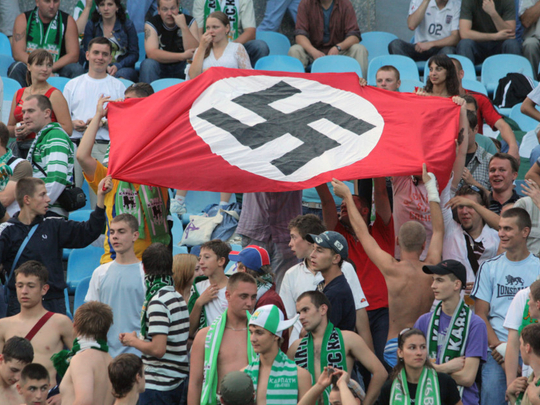
A darker emblem looms over the heated conversation about a controversial American symbol. To hammer home how problematic the continued state-sanctioned tolerance of the Confederate battle flag is in parts of the United States, some have drawn comparisons to the infamous banner of Adolf Hitler’s Nazi Germany.
“It would be like having the swastika flag flying on your next-door neighbour,” said Whoopi Goldberg, on ABC’s The View on Monday.
To be sure, Nazi Germany was a vastly different political entity than the Confederacy and existed in a vastly different historical context.
But the growing backlash against the Confederate flag does suggest that, a century and-a-half-later, Americans are finally accepting what Goldberg and many others believe it has represented all along: Not heritage, nor pride, nor a badge of Southern identity, but a regime of white supremacists who went to war against the Union to preserve the inhuman institution of slavery.
That is a legacy and ideology that does not deserve to be honoured by government institutions in the 21st century. And it is in that sense where the comparison to the Nazi swastika is most apt. After the Second World War and the defeat of the Third Reich, which survived nearly three times longer than the Confederate States of America, the insignia and flags of Nazism were banned. They were stripped from uniforms, detonated off the facades of buildings and eventually deemed a violation of Germany’s criminal code as symbols of an unconstitutional organisation.
According to a 1946 article in Time magazine, the occupying Allies embarked on a ruthless quest to expunge any trace of Nazi iconography, reducing “to pulp literature, museum and library material, newspapers, films and war memorials” connected to Hitler’s regime. Only tombstones were spared. To this day, it is illegal to display a Nazi swastika or any other associated logo or perform the “Heil Hitler” salute — even sometimes as an act of satirical, anti-fascist protest.
Never will you find a serious German politician, let alone one contending for the leadership of the country, insisting in 2015 that the Nazi swastika is “part of who we are”. Nor would you be able to stock up on kitsch, “nostalgic” Nazi memorabilia. There are no vainglorious monuments to Nazi leaders lining German city squares; instead, in the heart of the capital, sits a painful testament to collective guilt and the horrors of the past.
The contrast between this and the way some American states still commemorate Confederate leaders, name roads after Confederate generals and fly Confederate flags could not be more stark.
The Civil War may have put slavery to an end, but as the shooting in Charleston, South Carolina, made clear, cultures of hatred remain. The Confederate battle flag, now at the heart of so much controversy, was revived almost a century after the war by Southern groups opposed to efforts toward desegregation. It became an enduring emblem of the country’s deeply entrenched systems of inequity.
This is not to say that a toxic ideology simply dies out with the retirement of its symbol.
Nazism and its political allure hardly faded overnight with the scrapping of the Nazi swastika. The “denazification” efforts launched by the occupying Allies had limited effect. As the late historian Tony Judt chronicles in his book Postwar, considerable sympathy for the old regime remained in the years that followed the end of the Second World War.
A 1946 poll of West Germans found that one in three agreed with the proposition that “Jews should not have the same rights as those belonging to the Aryan race”. Another poll in 1952 found that some 25 per cent of West Germans still held a “good opinion” of Hitler.
After 1949, there was a climate of amnesia in West Germany about the misdeeds and horrors of Hitler’s genocidal rule, as well as a degree of resentment of the Allies’ treatment of their defeated foe. “The overwhelming majority of West Germans were clearly in favour of ... forgetting everything having to do with Nazism,” wrote the German historian Norbert Frei. The new government of Chancellor Konrad Adenauer eventually set up sweeping amnesty for former Nazi officials and party members.
Judt lays out the extent of the Nazi rehabilitation:
* In Bavaria [once the heartland of Nazi party], about half the secondary schoolteachers had been fired by 1946, only to be back in their jobs two years later. In 1949, the newly-established Federal Republic ended all investigations of the past behaviour of civil servants and army officers.
* In Bavaria in 1951, 94 per cent of judges and prosecutors, 77 per cent of finance ministry employees and 60 per cent of civil servants in the regional Agriculture Ministry were ex-Nazis. By 1952, one in three of Foreign Ministry officials in Bonn was a former member of the Nazi Party.
Historians argue that this was largely tolerated by the US and other countries in the West because of the looming shadow of the Cold War and the need to keep West Germany on side. It set up a more painful reckoning in West Germany in the decades ahead.
“The emergence in West German society of a serious and open confrontation with the Nazi past,” wrote Frei, “was made possible only by a very different preceding period — a period of utmost individual leniency, reflecting a policy for the past whose failing would stamp the new state’s spirit over many decades”.
In the US, some would say a long-deferred reckoning is perhaps now taking place.
In Germany, the censorship of Nazi symbols is still a matter of debate — with many wrestling over the dual necessity of preserving liberal freedoms while also recognising the evils of the Third Reich. Far-right and even neo-Nazi groups exist and organise in the country, but raising the Nazi swastika is a red line that no one can cross.
Instead, at times, some European fringe groups have come up with another symbol to represent their hateful creed: The Confederate flag.
— Washington Post








